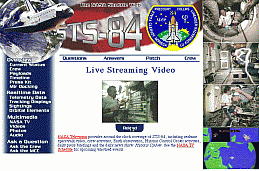|
 |
If you see this icon on our Home Page, and one of those infernal comments that you are not using our proxy server, all you have to do is click on the icon OR the blinking line, and it will take you through the steps required to set up your proxies. |
The proxy is one of those rare items where everyone benefits. If you use our proxy, at worst, your pages will load at the same speed as without the proxy. Statistics recently gathered however, show that about 47% of all requests have been able to be supplied from the proxy, so there is a significant benefit to subscribers who use the proxy. The more people who use the proxy, the more diverse the range of sites that get cached, and the better chance any given page will be in the cache. Next, the more people who are using the proxy, and therefore benefiting from the cache, the more of our bandwidth will be free to fetch pages that are not in the cache already, so even pages which are NOT in the cache, load even faster.
 ISP Charges... When is $1 MORE than $5? ISP Charges... When is $1 MORE than $5?
There has been a lot of discussion over the last 12 months about ISP charges. Many people are unaware of the difference between providers, and why their charges are different. Few subscribers have been in business and may not appreciate the costs involved, so perhaps a few words on this will help. An ISP must juggle a number of variables to produce a mix that will suit their target market.
- How many modems
- How much incoming bandwidth
- What level of support
- What hours should that support be available
- Location of site(s) and office
- Additional value-added services
- What quality equipment
1. The number of modems is a complex issue that few ISPs agree on. Most agree that more than 50 users per modem is bad. ("Modem:User ratio"). Few ISPs can operate at less than 8:1 ratio. Our policy is to maintain a close watch on the number of FREE modems, and when that number gets close to zero (ie, congestion point), we add more. Our aim is to have no congestion, rather than maintain some arbitrary modem:user ratio, as these ratios make no allowance for the usage patterns. To illustrate, imagine you were charged $20 per hour. You would be on, do your business, and log off as quickly as possible. 10 modems may quite happily support 500 users without people ever experiencing busy modems. On the other hand, if you were charged $10/month regardless of the number of hours you were on line, you may be inclined to leave your computer on-line all the time you were there, checking for mail every couple of minutes. In this case, the ISP would need perhaps 250 modems to adequately support the same 500 users. This scenario would almost certainly result in Telstra pushing for "Timed local calls".
Each additional modem costs money, both to purchase, and in Telstra line rental.
2. Next is the issue of bandwidth. How much is required. Bandwidth is perhaps the single most expensive component of the on-going costs of an Australian ISP. The more modems you have, the more bandwidth they can demand. As an example, if 10 modems were all downloading at 3KB/Second (reasonably typical for a 28K8 modem), it would require 30KB/Sec from the ISPs feed. If the ISP were to double the number of modems without doubling their bandwidth, each modem could only get half the data they are capable of (thus, it would take twice as long). The issue of bandwidth is complex, because caching, user mix, peering and connection points all have a significant role. Even without the ISPs link being congested, there are sites worldwide that simply cannot send data quickly enough to keep even a 14K4 modem going at full speed.
3.&4. Support also costs the ISP quite a lot. Even a modest staff of technical support people, running 12 hours/day, 7 days/week, costs thousands of dollars a week.
5. Most ISPs operate from back rooms, cupboards or a spare desk at an existing business who are frequently paid a nominal rent for a few square feet of floor space. One national ISP offered us the massive sum of $2,000 per YEAR to house their equipment! Most of these ISPs have their equipment in operating conditions that are not optimal. No airconditioning, not protected from dust or office hazards, few even have basic power conditioning. By not having a contact point (office or shopfront), an ISP can save a lot of rent. This usually also means that the ISP cannot (or will not) offer any technical support or training beyond the phone. Many ISPs attempt to recover costs of technical support by charging for their support calls (some at up to $2.00/minute!)
6. Additional services, like public-access terminals, hands-on training, newsletters, advice and non-Internet technical support all cost money to provide.
7. Equipment quality, and the environment it is kept in, are a major component in the overall reliability of an ISPs service. Consumer-grade components, while less expensive to purchase, are rarely designed to operate all day and all night, for months or years on end. Professional grade equipment, operated in a constant temperature, clean environment, with fully conditioned power, will generally operate properly and without intervention for extended periods. Some of our servers have been operating non-stop for upwards of 10 months without even being re-booted (and they would have been going longer than that if it were not for equipment or software upgrades).
Here at ALI, we try to maintain enough modems so that even at our busiest time (typically about 9pm), we still have free lines. This peak load determines how many modems we need. In order that you can get reasonable access speeds during these times, the number of modems determines how much bandwidth we need. Modems usage varies from one time of the day to another, and the average over 24 hours, divided into the cost of operating those modems and associated bandwidth gives an hourly cost. To lower the hourly cost can be done in only a few ways:
- Increase the modem utilisation. If we had 5 times the number of subscribers we currently have, most of our modems would be in use most of the time. This would reduce our hourly charge, but many of our subscribers would be unable to access the internet because all our modems would be in use already. We consider this unacceptable.
- Reduce the bandwidth to the internet. If we cut our bandwidth to the internet, our expenses would be lower, but everyone would find access to the internet would be much slower than it is now. We consider this unacceptable also.
- Discontinue many of our extra services. We could reduce the number of people working at our offices, but that would see an end to our support line. No more technical support, no walk-in centre. And, if we don't have people at the counter, no more cash accounts. No more $40/20 plans. The remaining staff would be too busy to process cheques so everything would be automated and require credit cards. No posted accounts and no newsletters. We don't much like this option either!
So, given the alternatives, we believe that much like the supermarket where you can buy the cheaper "no-name" product, or the premium product, the same choice exists with Internet access. If you don't need the extras, don't mind slower access, and don't mind if you cannot even access the internet at times, perhaps another account with another provider is appropriate. We keep hearing from people who have accounts with other providers for $1/Hr or $2/Hr, how they have spent 4 or 5 hours downloading a file, yet the same file took under an hour through their account with ALI. Given our charges range from $3.75 to $5/Hr, it's still cheaper than 4 or 5 hours at $2/Hr!
 e-mail off-line e-mail off-line
Did you know you do not need to be on-line to read or write your e-mail, only to send and collect it!
If you are experiencing problems collecting your mail, or can't remember how to - call us, or check the e-mail section of our New Users Guide (in particular, click on the words and how do I use it).
We have had a number of cases of mail-locks lately. These can occur if your call was terminated (cut off) abnormally while you were collecting your mail. If you tried to dial straight back in you might find you cannot access your mail. Mail-locks will normally clear themselves if left alone, this may take up to 10 minutes. In some rare cases the call can terminate at a vulnerable point in your mail transfer where it is unable to clear itself. If your mail-lock has persisted after an hour (during which neither you nor anyone else has tried to access your mail) call us (during support desk hours - 9am to 9pm) and we will manually clear the mail-lock for you. You should then be able to collect your mail.
We have noticed some people have not checked their e-mail for months! |
 |
Please, check your mail at least weekly. When there are important announcements, particularly if we don't have time to advise you in our newsletters, we'll e-mail details. Your itemised account is also sent by
e-mail. If you have a LOT of mail unclaimed, you will be charged for it.
 Modems and Speed. Modems and Speed.
OK, so it's time to trade up from your old 14400 bps modem. You've been to the shops, read the mags, and are confused. 28K8, 33K6, 56K, Voice, Fax, SVD, Internal, External. Argh! Help!
After the 14K4 modems (V32bis) came the next leap in speed to 28K8 (28,800 bps) (V34 and VFC), and then the V34bis and V34+ standards for 33K6 modems. History proved that VFC as a standard, was the wrong answer when V.34 was ratified internationally. The V34bis/V34+ battle has still been raging. Ultimately, one will be the "winner" but as yet, we don't know which one. The point may become irrelevant as the battle for 56K progresses. Currently, there are two incompatible 56K solutions being put forward. one by US Robotics (their X2 spec), the other by 600 modem manufacturers (everyone else!) (K56Flex). There are a lot of points people are NOT being made aware of with 56K at this stage. These include (in no particular order):
- One end of the link MUST be digital. (About $50,000 to install) Without it, it is impossible to get anything better than V34 speeds.
- The link is asymetrical (ie, download speeds up to 56K, upload at 33K6)
- X2 modems will NOT connect with K56Flex modems at anything faster than V34
- Speeds are NOT guaranteed to be 56K. This is only the speed the modem is guaranteed NOT to exceed!. In Australia where it's just been approved, we're seeing most connects at up to about 48kbps, with a few connects up to 51-53kbps, although these seem to be rare.
- In our rural areas, many exchanges perform more than one analogue-to-digital conversion, and speeds above 28K8 are unlikely, speeds over 33K6 impossible.
- 56K modems will not be able to connect to each other at anything better than V34, so don't expect to call your mates to play doom over modem at 56K!
- Service providers worldwide, are charging a premium for 56K services. It costs them more to install and consumes more of their precious (and expensive) bandwidth. Don't be surprised if you start paying ISDN prices for 56K modem connects.
Modems ... decisions, decisions.
What to go for ... fax, voice, SVD (Simultaneous Voice & Data) and internal or external solutions. We've already discussed the internal vs external decision in previous newsletters, but in brief, strongly recommend external modems.
Virtually all modems available on the market today are able to send and receive faxes. Voice and SVD modems are being mis-represented by many sales people who simply don't know what they are selling. If you wish to send voice over the internet, you do NOT need a voice modem! |
 |
Voice modems usually have the ability to operate as a voice-mail box and/or answering machine. I wonder about the economics of a $400 modem, connected to your $3000 or more computer, left running all day and all night, vulnerable to lightning strikes and power spikes, when an answering machine costs only $150 or so!
SVD modems will allow you to call someone else with a similar compatible modem (not all SVD modems will work with each other) and talk with them whilst sending data. I don't know more than a handful of people who have a requirement or interest in this application.
 Live streaming video through your Browser Live streaming video through your Browser
A number of sites on the Web are experimenting with a variety of different live video options you can view with your Web Browser. We at ALI are using a live still of our Walk-In Centre for both it's icon (on our On-Line page) and a larger version on the Walk-In Centre's pages. The image is automatically updated every 30 seconds from a live colour camera at the Walk-In Centre.
One of the most exciting examples of live video over the Web has been NASA's experiment with live streaming video using Web Cam technology developed in the Netherlands. The last few Shuttle launches have been broadcast over Web Cam as well as their normal CuSeeme channels. Web Cam is in colour, and the audio is provided using either Speak Freely (a freeware application you can download, automatically plays the audio streaming with the video) or RealAudio live stream playing real-time audio.
We regularly turned our Walk-In Centre Browsers to NASA's Web Cam sites during the recent Atlantis mission, using Internet Explorer V3.01 on the Windows machines, Netscape V2.02 on OS2 and both Netscape and IE AND RealAudio on the Mac. Video was good on all machines and audio was generally excellent from RealAudio on the Mac.

The screen captures above show the Shuttle mission page. The video would update in real time in the video window in the middle of the web page for up to 2 minutes, after which you would have to hit Reload. The screen shots in the panel to the right in the picture above are snaps taken from the Tour of the Mir Space Station broadcast and watched live by Web Surfers all over the world.
9 August 1997 - NASA's live streaming video is currently available from http://www.unitedspacealliance.com/live/videon.htm. This is subject to change without notice.
 |
The Space Shuttle Atlantis (left) and the Mir Space Station (below). |
|
NASA keeps a large selection of videos (mpegs) still photos (jpgs) and audio clips available for download (warning - they can be BIG files). They also have extensive on-line Mission information and schedules available, and forums where you can ask questions of the Shuttle crew or Mission Control.
NASA's Shuttle Web can be found at http://shuttle.nasa.gov/ |
 |
 NEWS & RECENT EVENTS NEWS & RECENT EVENTS
Training Courses Surveys
Response to the last two on-line surveys has so far been pitiful. The message we are getting is that you don't really want training courses or cheaper access options.
If you do PLEASE, PLEASE drop into: http://www.albury.net.au/survey/training.htm and http://www.albury.net.au/survey/chatnet.htm and tell us what YOU want!
If we don't get enough responses we will have to reconsider the future of both projects.
Phone number changes.
Starting soon, Albury telephone numbers are changing. Our local POP will change to 60403000. Now is a good time to check you are calling the best number for your location. Remember, we have Points of Presence (POPs) in various locations throughout our region, from Mt Beauty to Culcairn and Corowa to Corryong. Please visit our "best POP" page at http://www.albury.net.au/locals-only/pop.html
Earn yourself $10 for every new Subscriber you join up ...
Did you know that signing up a friend, neighbour, relative, associate etc is worth $10 per sign-up in free access to you on our New-Subscriber Incentive Plan? All you have to do to get your free time is make sure the new subscriber signs up on our standard application form that has YOUR EMAIL ADDRESS in the dealer space at the bottom right of the form. Forms are available from our Walk-In Centre.
 Calling the Help Desk for support: Calling the Help Desk for support:
- First and foremost - READ YOUR NEWSLETTERS - particularly our February Special Edition
Troubleshooting Guide. This covers most commonly experienced problems and solutions.
- Ensure you have thoroughly documented the symptoms of your problem BEFORE calling the Help Desk - i.e. WRITE DOWN any error messages you are seeing EXACTLY as they appear. DON'T rely on your memory. A thorough description of your suspected fault will not only assist Help Desk personnel to resolve your problem, but you may find the solution yourself simply by looking more closely at the problem!
- Help Desk hours are between 9am and 9pm - 7 days week. Make sure to identify yourself & have your username & password ready.
|

 Modems and Speed.
Modems and Speed. Live streaming video through your Browser
Live streaming video through your Browser




